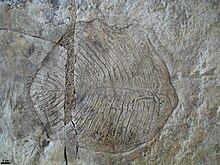Yorgia
| Yorgia waggoneri Temporal range: Ediacaran
| |
|---|---|

| |
| Fossil of Yorgia waggoneri | |
| Scientific classification | |
| Domain: | Eukaryota |
| Kingdom: | Animalia |
| Phylum: | †Proarticulata |
| Class: | †Cephalozoa |
| Family: | †Yorgiidae |
| Genus: | †Yorgia Ivantsov, 1999 |
| Species: | †Y. waggoneri
|
| Binomial name | |
| †Yorgia waggoneri Ivantsov, 1999[1]
| |
Yorgia waggoneri is a discoid
Etymology
The generic name Yorgia comes from the Yorga river on the Zimnii Bereg (Winter Coast) of the White Sea, where the first specimens were found. The specific name Yorgia waggoneri honors the American paleontologist Ben Waggoner, who found the first specimen.
Morphology

The body plan of the Yorgia and other proarticulates is unusual for solitary (non-colonial) metazoans. These bilateral organisms have segmented metameric bodies, but left and right transverse elements (
The integument of the dorsal side were unsegmented and covered with small tubercles, same as with
Fossil record
Imprints of the species Yorgia waggoneri have been found in the rocks of
Trace fossils
Taphonomic details revealed in Yorgia allow interpretation of the chains of positive imprints of other proarticulates as grazing traces, as opposed to trails created as organisms were swept along the sea floor by currents. In addition to Yorgia, two fossil taxa, Epibaion and Phyllozoon, seem to have produced similar grazing traces. Small groups of positive body imprints are documented for Dickinsonia costata as well and Dickinsonia cf. tenuis.[12][14]
See also
References
- ^ Ivantsov, A.Y. (1999). "A New Dickinsonid from the Upper Vendian of the White Sea Winter Coast (Russia, Arkhangelsk Region)". Paleontological Journal. 33 (3): 233–241.
- ^ a b Ivantsov, A.Y. (2001). "Vendia and Other Precambrian "Arthropods"". Paleontological Journal. 35 (4): 335–343.
- ^ a b Ivantsov, A.Y. (2004) "Vendian Animals in the Phylum Proarticulata". The Rise and Fall of the Vendian Biota. IGSP Project 493. Abstracts. Prato, Italy, p. 52.
- S2CID 89131248.
- ^ Ivantsov, A. Yu.; Zakrevskaya, M. A.; Nagovitsyn, A. L. (2018). "Morphology of the covers of Proarticulata (Ediacaran Metazoa)" (PDF). Ist Palaeontological Virtual Congress. Book of Abstracts.: 65.
- .
- . Retrieved 29 January 2023.
- ^ Grazhdankin, D. V.; Maslov, A. V., Mustill, T. M. R.; Krupenin, M. T. (2005). "The Ediacaran White Sea Biota in the Central Urals". Doklady Earth Sciences. 401 (6): 784–788.
{{cite journal}}: CS1 maint: multiple names: authors list (link) - .
- PMID 21680416.
- S2CID 55178329.
- ^ a b Ivantsov, A.Y.; Malakhovskaya, Y.E. (2002). "Giant Traces of Vendian Animals" (PDF). Doklady Earth Sciences. 385 (6): 618–622.
- S2CID 128741869.
- S2CID 17181699.
